Al principio, está la página de aterrizaje.
A menudo es la primera impresión de una empresa: una introducción digital a una organización, el problema que aborda y las soluciones que ofrece. La sofisticación de las páginas de aterrizaje puede variar. Algunas empresas utilizan su página de inicio como página de aterrizaje. Otras crean páginas específicas que se dirigen a perfiles discretos de clientes y los mueven a través de un embudo de marketing.
Las páginas de aterrizaje también adoptan diversas formas según la etapa de crecimiento de una empresa. Pero ese es uno de los errores comunes que veo: las páginas de aterrizaje priorizan la historia de la Startup antes que el recorrido del cliente con la Startup.
La copia de la página de aterrizaje mejora cuanto más se vean los clientes en ella. Replantea y revisa tu página de aterrizaje construyéndola en torno a tres elementos. Si eso es demasiado esfuerzo y buscas soluciones rápidas, los siguientes consejos mejorarán la copia actual de tu página de aterrizaje.
Ganancias rápidas para una mejor copia de la página de aterrizaje
Enfoca la copia en ellos. Las páginas de aterrizaje a menudo dicen «ofrecemos» o «nuestra solución», que se centra en lo incorrecto: tu empresa, no tus clientes. Revisa cada oración de tu texto y vuelve a escribirla para dirigirte a tus clientes. Una forma de hacerlo es comenzar con la palabra «tú». Otro consejo es comenzar tu oración con un verbo. Centrarte en ellos casi garantiza que tu texto se dirigirá a tu visitante y hablará con él. Modern Fertility proporciona un buen ejemplo de cómo es esto:
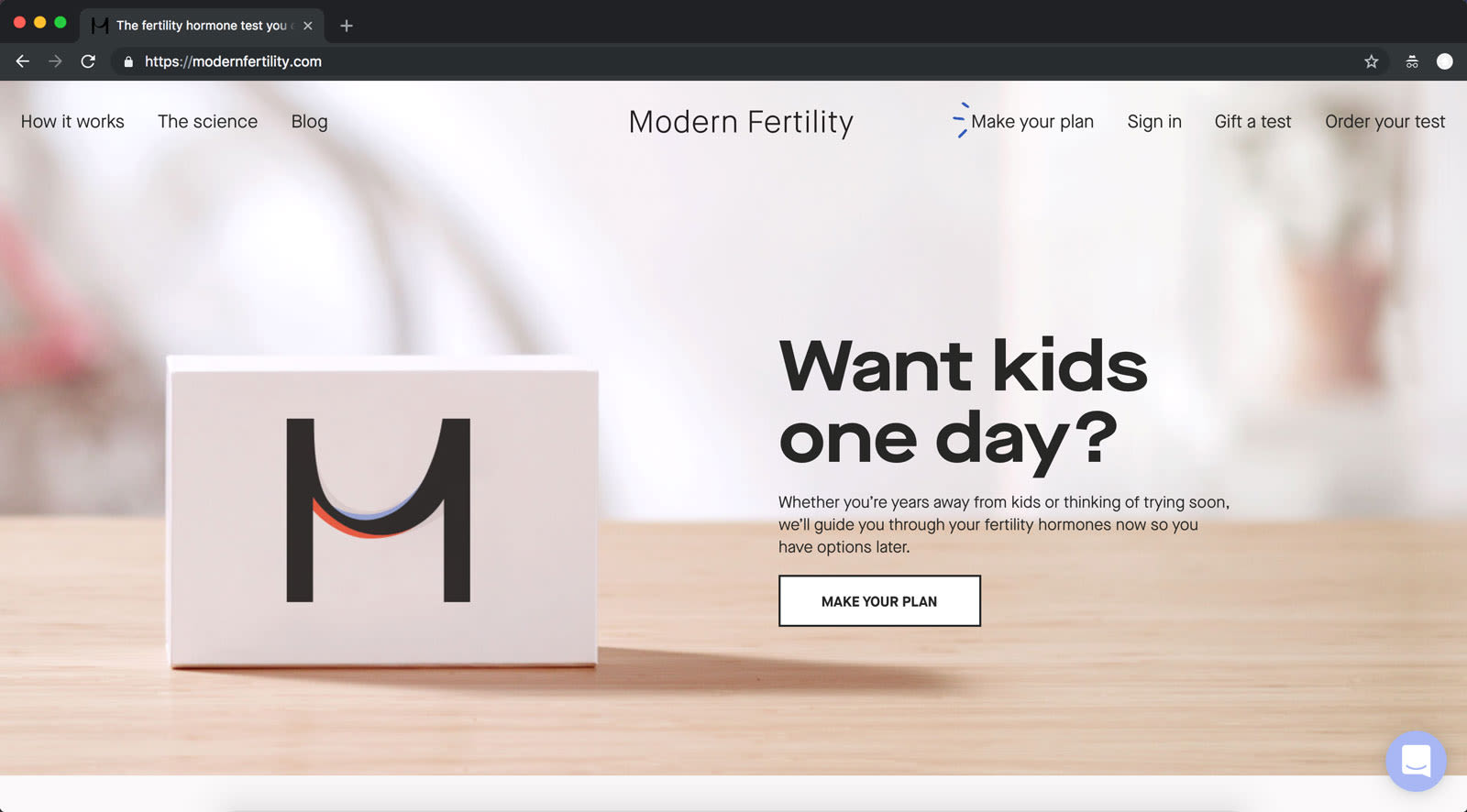
La única excepción posible para liderar «contigo» en tu copia es si tú eres una empresa de servicios, en la que los prospectos quieren ver lo que haces de manera diferente como proveedor de servicios. Eso a menudo se expresa como lenguaje «nosotros». Pero no tiene por qué ser así. Simplemente muy a menudo lo es.
Agrega patrón, textura y brillo a un bloque de copia. La copia precisa, concisa y gramaticalmente correcta puede parecer plana. Los patrones, la textura y el brillo pueden agregar otra dimensión a tu copia, haciéndola más atractiva y memorable. A continuación, te explicamos cómo:
Aplica un patrón a una oración. Se pueden usar patrones para referenciar sutilmente un logotipo o trazar un tema. Tomemos una empresa logística que transporta mercancías por ferrocarril. Tal vez no solo quiera entregar un mensaje sino también simular un tren con un patrón de puntos espaciados uniformemente en una línea horizontal. Si deseas imitar esa visual, reescribe la copia de la página de aterrizaje para enlazar solo palabras de longitud similar, como palabras de tres o cuatro letras.
Varía la longitud y el formato de la oración para crear textura. La textura puede hacer que la copia se sienta más conversacional, natural y atractiva. Cuando buscas crear textura, escribe una oración suave y pulida y yuxtaponla con una oración más entrecortada. Pon algunas oraciones cortas. Más. Más. Y tal vez una más. Y luego agrega una oración que vaya mucho más lejos, usando cláusulas para atraer a tu lector. Luego detente. ¿El resultado? Textura.
Incluye una o dos palabras brillantes para destacar. Perfeccionar podría significar cambiar unas pocas palabras nuevas. Busca una palabra suave en tu copia y reemplázala por un sinónimo más deslumbrante. Toma la copia de la página de aterrizaje de los retiros colectivos a continuación. En lugar de «Buscar destinos sin perder lujo», prueba «Explorar destinos extraordinarios sin sacrificar el lujo». El adjetivo brillante y los verbos más fuertes agregan fuerza a la copia.
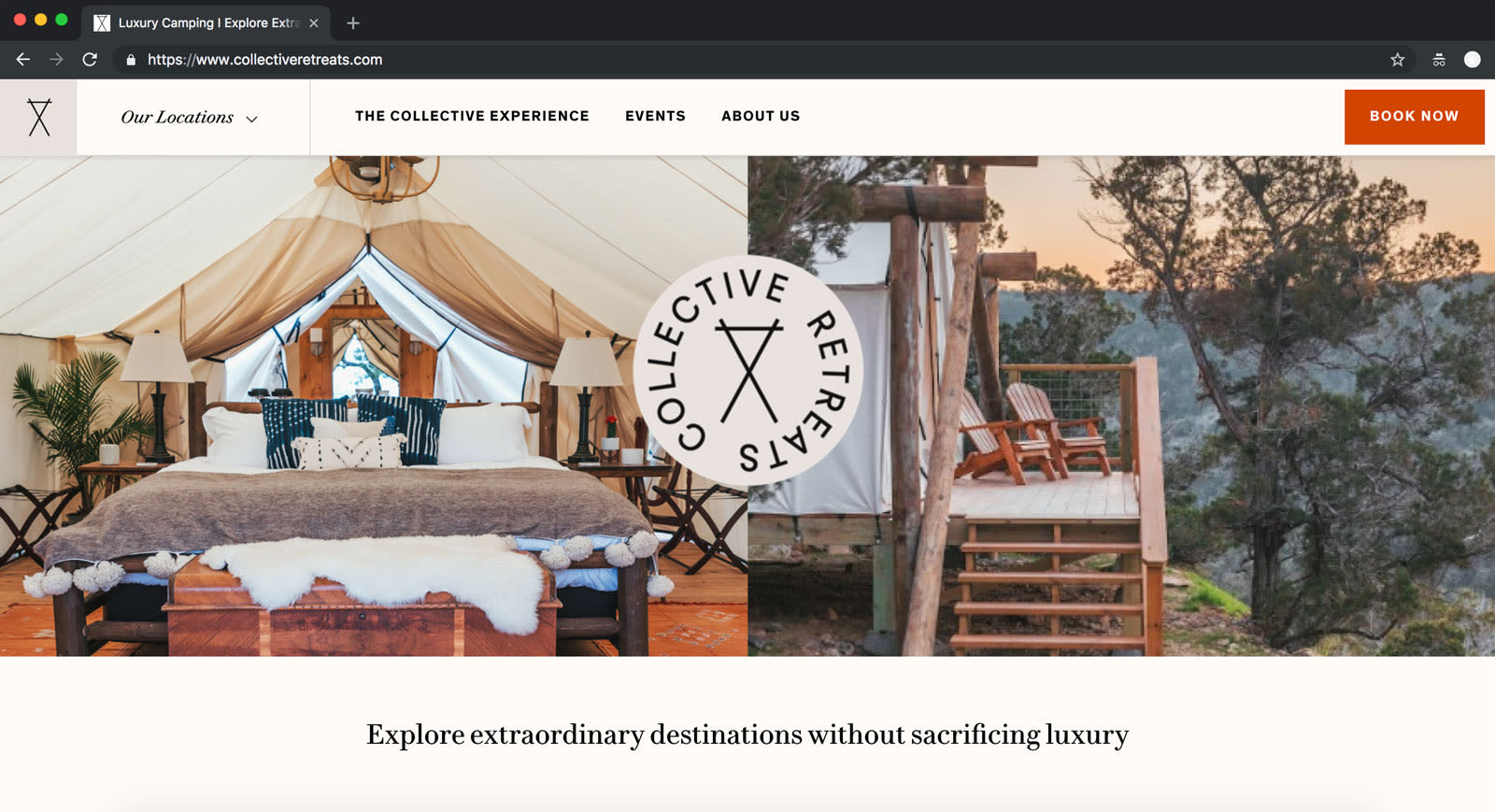
Elimina las objeciones con una cláusula «aunque». Si puedes anticipar lo que podría impedir que alguien crea tu afirmación o aserción, socava esa oposición reconociéndola. Darás a entender que comprendes su miedo, incertidumbre y duda y sugerirá que tu solución tenga en cuenta esas consideraciones. La fórmula es simple: «[afirmación] aunque [objeción].» Un ejemplo muy simple es: «sé creativo aunque no seas creativo.» Aquí tienes una cláusula «aunque» en la naturaleza:
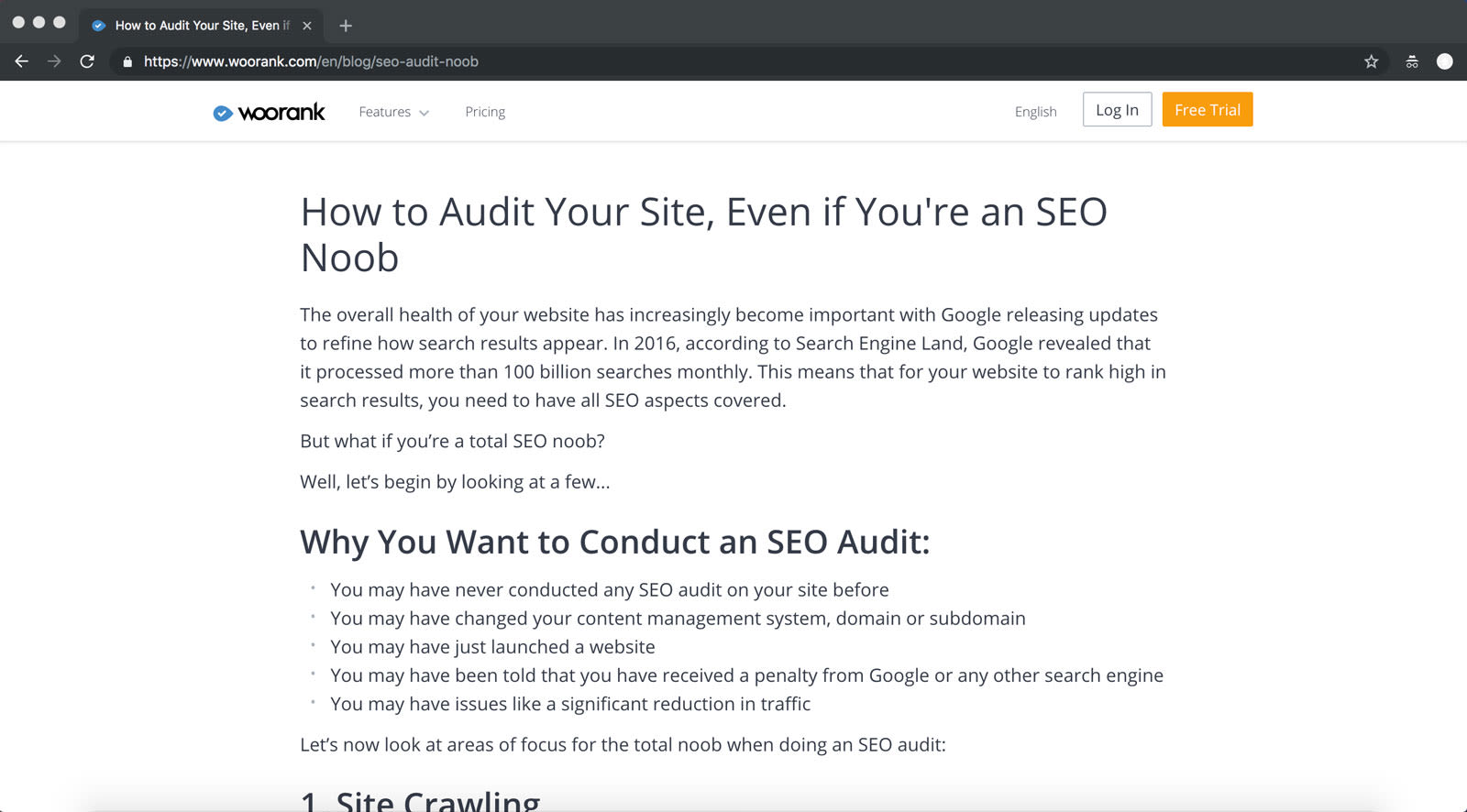
Limita cada oración a una idea. Las oraciones tienen la capacidad de llevar mucha información, pero tu lector no. Tus lectores dependen de los puntos, signos de interrogación e incluso signos de exclamación para darles a sus cerebros un breve descanso, lo suficiente como para absorber información antes de continuar. Cuanto más ayudes a los lectores con la digestión de la información, más apetito tendrán para seguir leyendo. Así que edita cada oración para tener un solo pensamiento. No dos. No tres. Apple es hábil en esta técnica, pero incluso tiene oportunidades:

Llévate tu copia para Apple TV 4K. La mayoría de las oraciones no califican como oraciones, pero siguen absolutamente la regla. Esta es la que no lo hace: «Apple TV 4K te permite ver películas y programas en increíble HDR 4K y ahora completa la imagen con sonido inmersivo de Dolby Atmos». Esta oración combina dos funcionalidades distintas. El lector promedio sería más capaz de tomar la información si esa oración se rompiera en dos:
Apple TV 4K te permite ver películas y programas en increíble HDR 4K. Tiene sonido envolvente de Dolby Atmos. Transmite tus canales favoritos en vivo. Tiene gran contenido de aplicaciones como Netflix, Amazon Prime Video y ESPN. Y gracias a Siri, puedes controlarlo todo solo con tu voz.
Crea una página de aterrizaje que no sea tu página de inicio. Si recientemente creaste un sitio web para tu empresa, tu página de aterrizaje podría ser tu página de inicio, pero son dos criaturas diferentes. Una página de aterrizaje está diseñada para convertir a los prospectos en clientes. Habla con los visitantes que buscan algo específico, presenta contenido relevante para ese ítem en particular y contiene una llamada a la acción (CTA) personalizada para esa oferta precisa. Por otro lado, una página de inicio atiende a un público amplio, cuenta con contenido ampliamente relevante y puede no tener una CTA inmediata.
Las empresas más sofisticadas enrutarán a los visitantes que, por ejemplo, buscan productos para grandes empresas a una página orientada a las empresas en lugar de una página de inicio con información general. Si tienes un sitio web con más de una página o una arquitectura de información y un mapa del sitio más avanzados, considera la posibilidad de enlazar a la página de tu sitio que mejor se adapte a la intención de un visitante.
Elementos fundamentales de la copia eficaz de la página de aterrizaje
Primero, el spoiler: la copia de la página de aterrizaje nunca se hace. Al igual que tu empresa, evolucionará (y debería) con el tiempo. Es un proceso iterativo y siempre se puede mejorar. Hay cientos de fórmulas de redacción (muchas de ellas documentadas aquí) que pueden ayudarte a elaborar un titular, redactar viñetas o estructurar un CTA. Pero si no tienes los fundamentos abajo, la mejora será incremental, no cambiará el juego.
La copia para una página de aterrizaje de alto rendimiento tiene tres cualidades fundamentales:
Entrega una primera impresión convincente de la Startup. En un nivel fundamental, esto implica una copia directa, específica y gramaticalmente correcta. Ese nivel de precisión y profesionalismo establece expectativas y eleva la vara para futuros compromisos con el producto y el equipo de una empresa.
Considera la madurez del mercado. Cada mercado, como toda empresa, está en su propia etapa de desarrollo. Las empresas en mercados altamente maduros pueden usar textos cortos porque la mayoría de los visitantes ya obtienen los pormenores de la solución o categoría (por ejemplo, maquinillas de afeitar desechables). Su enfoque debe estar en los diferenciadores de productos, la historia de la marca y quién la está usando. Si un mercado aún está emergiendo (por ejemplo, criptomonedas en 2018) es probable que los clientes necesiten más información porque una empresa no solo está educando sobre su solución, sino que también ayuda a definir la categoría de manera más general.
Refleja la etapa de conocimiento del cliente. La copia eficaz de la página de aterrizaje refleja la comprensión del cliente, que está en capas e incluye: qué tan bien entiende el cliente el desafío al que se enfrenta la empresa (por ejemplo, la privacidad de los datos), lo que está en juego (por ejemplo, datos personales o cumplimiento de la normativa), el panorama cambiante (por ejemplo, el Reglamento General de Protección de Datos, RGPD) y las herramientas que ayudan (por ejemplo, un producto específico).
En resumen, un gran texto demuestra que una empresa comprende lo conscientes que son los clientes del mercado, sus puntos débiles y posibles soluciones. El mejor texto hace todo eso e indica que la empresa está incluida precisamente en lo conscientes que son los clientes de sí mismos. Estas son las cinco etapas de conocimiento para cualquier visitante de tu página de aterrizaje:
Más conscientes. Los visitantes entienden totalmente tu solución y es probable que crean que es un gran competidor para ellos. Solo necesitan impulsos. Las compras se realizan aquí.
Conoce el producto. Los visitantes están aprendiendo sobre tu producto. Aquí se ofrecen pruebas gratuitas, demostraciones y compras.
Solución consciente. Los visitantes están considerando soluciones a su malestar o problema.
Problema consciente. Los visitantes están sintiendo malestar o lidiando con un problema.
Desconocimiento. Los visitantes no han experimentado una necesidad que los lleve a tu solución.
La copia de la página de aterrizaje refleja al cliente si puedes responder «sí» a las siguientes preguntas:
¿Es accesible el idioma y refleja la etapa de conciencia de un visitante?
¿La copia los mueve de donde están a donde quieren estar?
¿Se les pide a los visitantes que tomen medidas una vez que conozcan el producto o más?
Los elementos de la copia de la página de aterrizaje en acción
Cada página de aterrizaje debe dar una primera impresión convincente, considerar la madurez del mercado y reflejar la etapa de concientización del cliente. La mejor manera de ver cómo la ausencia o presencia de estos elementos alteran una página de aterrizaje es revisar ejemplos de la vida real. Por lo tanto, teniendo en cuenta los tres elementos fundamentales, he evaluado las páginas de aterrizaje de nueve empresas: desde un software de gestión de miembros hasta una marca de golosinas vegana y un servicio de notificación de fechas judiciales. Aquí va:
Primera impresión: haz una introducción precisa, confiable y duradera
Empresa: Kapwing
Qué hace: editor moderno para videos, GIF e imágenes
Desafío de la página de aterrizaje: copia corta pero ambigua
La solución a aplicar: sé específico, pero primero, desplázate hacia abajo.
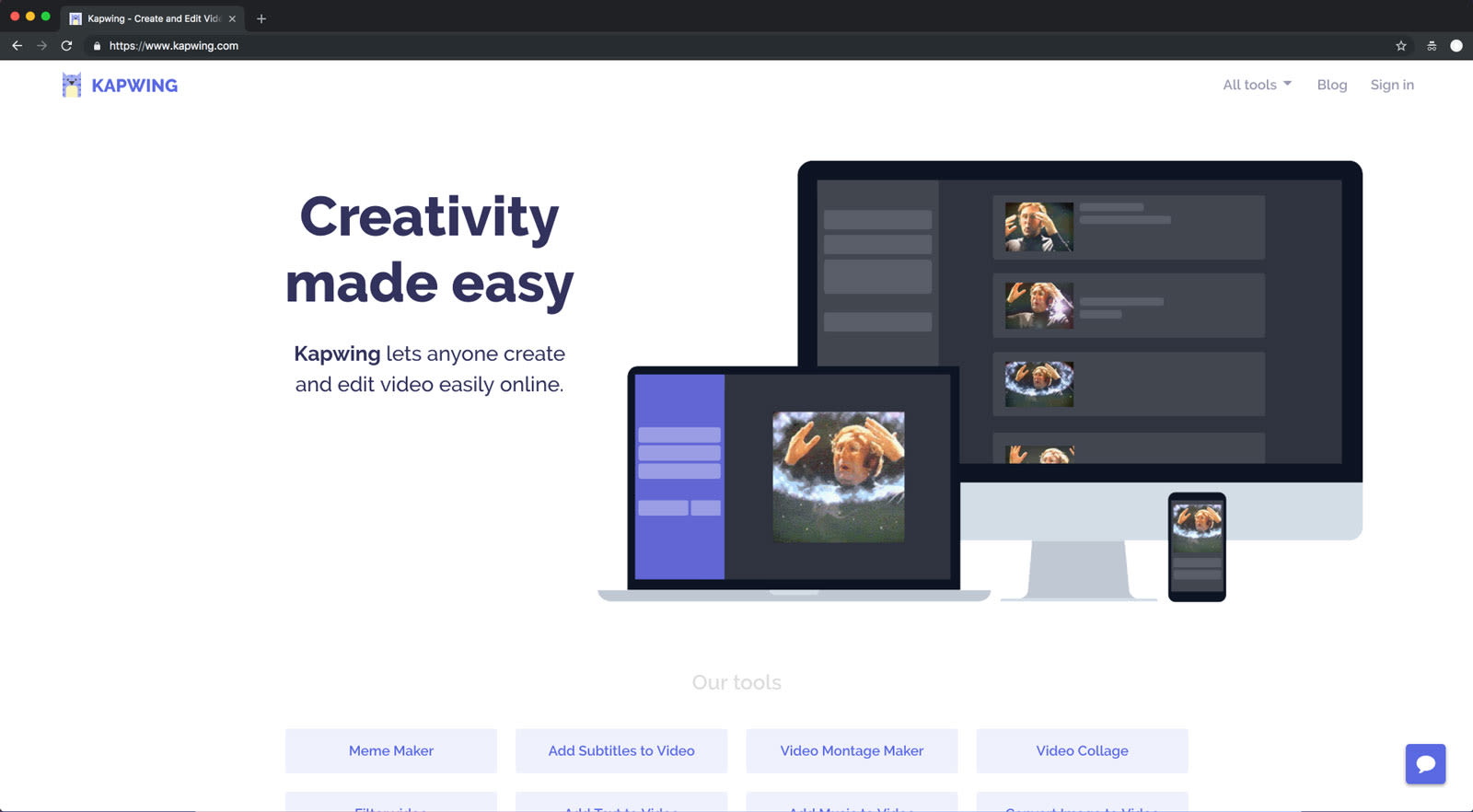
El análisis
El titular, «Creatividad facilitada», plantea la siguiente pregunta: ¿las personas que usan esta solución no son creativas? La frase sugiere que es difícil que tu audiencia sea creativa. ¿Es cierto?
La página es víctima del mito de que la copia debe ser corta a toda costa. Muchas Startups escriben titulares de tres o cuatro palabras que intentan decirlo todo. Reduce la presentación de un producto a un contratiempo. En el camino, nos decimos que estamos siendo concisos porque entendemos que ser breves es bueno cuando se trata de comunicación.
Pero ¿estás siendo breve o vago? Peor aún, ¿estás sacrificando un mensaje claro por uno corto? Tu titular es bienes inmuebles de alta calidad. Déjalo hacer algo de trabajo real, está hecho para ello.
Piensa en tus últimas 10 conversaciones con un cliente o cliente potencial. (Si no has tenido al menos 10, primero hazlo). ¿En qué momento de la conversación mejoraron? Ese es el alimento para un buen titular, al menos uno que vale la pena probar. Eso es lo que debería encabezar tu página de aterrizaje.
Con los titulares, no tomes comentarios ricos y matizados de los clientes y rebájalos a la versión más pequeña posible. En su lugar, escucha. Escribe lo que escuchas. Y ponlo en la página. Lo limpiarás para que sea de marca y persuasivo, pero no debe resumirse.
La preocupación al resumirlo es que te volverás demasiado vago. Las herramientas de Kapwing abarcan toda la gama. Hacen memes, agregan subtítulos a videos, crean montajes y mucho más. Si eres el equipo de marketing, la tentación es mirar todo lo que hace Kapwing, trazarlo en un diagrama de Venn y promover la parte superpuesta: la calidad que tienen en común todas las funcionalidades, casos de uso y resultados. Es probable que así sea como surgió la «Creatividad fácil».
Así es como aparecen los titulares mediocres, y esto sucede sorprendentemente a menudo, incluso a las Startups más expertas en copia. Muchos fundadores usan titulares más eficaces en sus presentaciones verbales de productos o en otros lugares en copia. Ese es el caso de Kapwing; las mejores opciones para un titular están más abajo en la copia:
Las tareas que tardan horas en iMovie tardan minutos en Kapwing.
Sin instalación. Sin contraseñas. Sin tutoriales técnicos. Funciona en todos los sistemas operativos, en tu teléfono y en tu computadora.
O
Trae los memes.
Los trabajos creativos que tardan horas en iMovie tardan solo unos minutos en Kapwing.
Cualquiera de las dos copias expresa la facilidad de ser creativo en Kapwing de una manera específica y convincente, y sirven como puntos de entrada a su otro conjunto de herramientas. Estos mensajes deben conducir a la página como titular. La copia de titulares ocultos les sucede a muchas empresas. No es que las empresas no puedan generar buenos titulares sino que es probable que los hayan descartado.
Empresa: WebGazer
Qué hace: monitoreo gratuito del sitio web
Desafío de la página de aterrizaje: copia centrada en nosotros
La solución a aplicar: «La regla de uno»
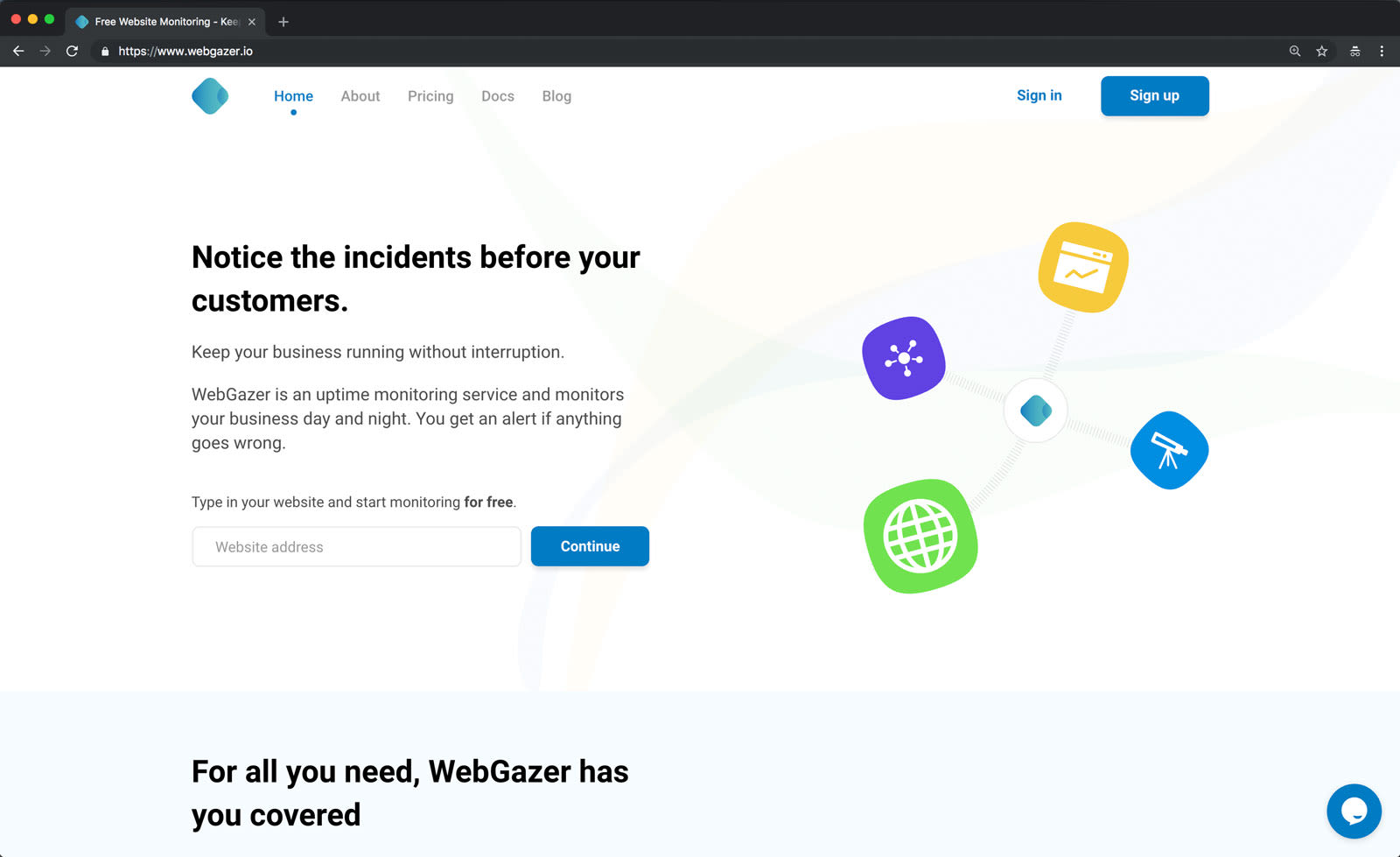
El análisis
Este encabezado funciona, siempre y cuando los visitantes lleguen a la página sabiendo qué es y qué hace WebGazer. La copia puede ser suficiente si se trata de una página de redireccionamiento.
Pero ¿y si no lo es? Comencemos con la frase: «te ayudamos a mantener tu empresa funcionando». La primera palabra («Nosotros») es un problema. La copia centrada en nosotros es un problema, casi sin falta. Se comunica desde la perspectiva de la empresa, no del cliente. Es el equivalente a que una persona se presente y domine el espacio aéreo con su historia. Corrige la copia centrada en «nosotros» reescribiendo cada frase para comenzar con la palabra «tú» o un verbo. Así es como WebGazer puede cambiar tres frases en su página de aterrizaje:
|
Copia centrada en nosotros
|
Copia centrada en ti
|
|---|---|
| Controlamos tus sitios sin descanso. Comprueba tú mismo todo lo que logramos hoy | Puedes tener tranquilidad, porque vigilaremos tu sitio sin descanso. |
| WebGazer verifica si tu sitio web funciona correctamente y te avisa si algo sale mal. | Logra que tu empresa que opera en línea funcione sin interrupciones. WebGazer se encargará de monitorearlo día y noche y te notificará si algo sale mal. |
| Te ayudamos a mantener tu negocio en marcha. | ¿Cómo puedes saber si tu sitio web dejó de funcionar de repente? |
Empresa: InfluenceKit
Qué hace: informes automatizados de contenido patrocinado
Desafío de la página de aterrizaje: una llamada a la acción oportuna
La solución a aplicar: AIDA
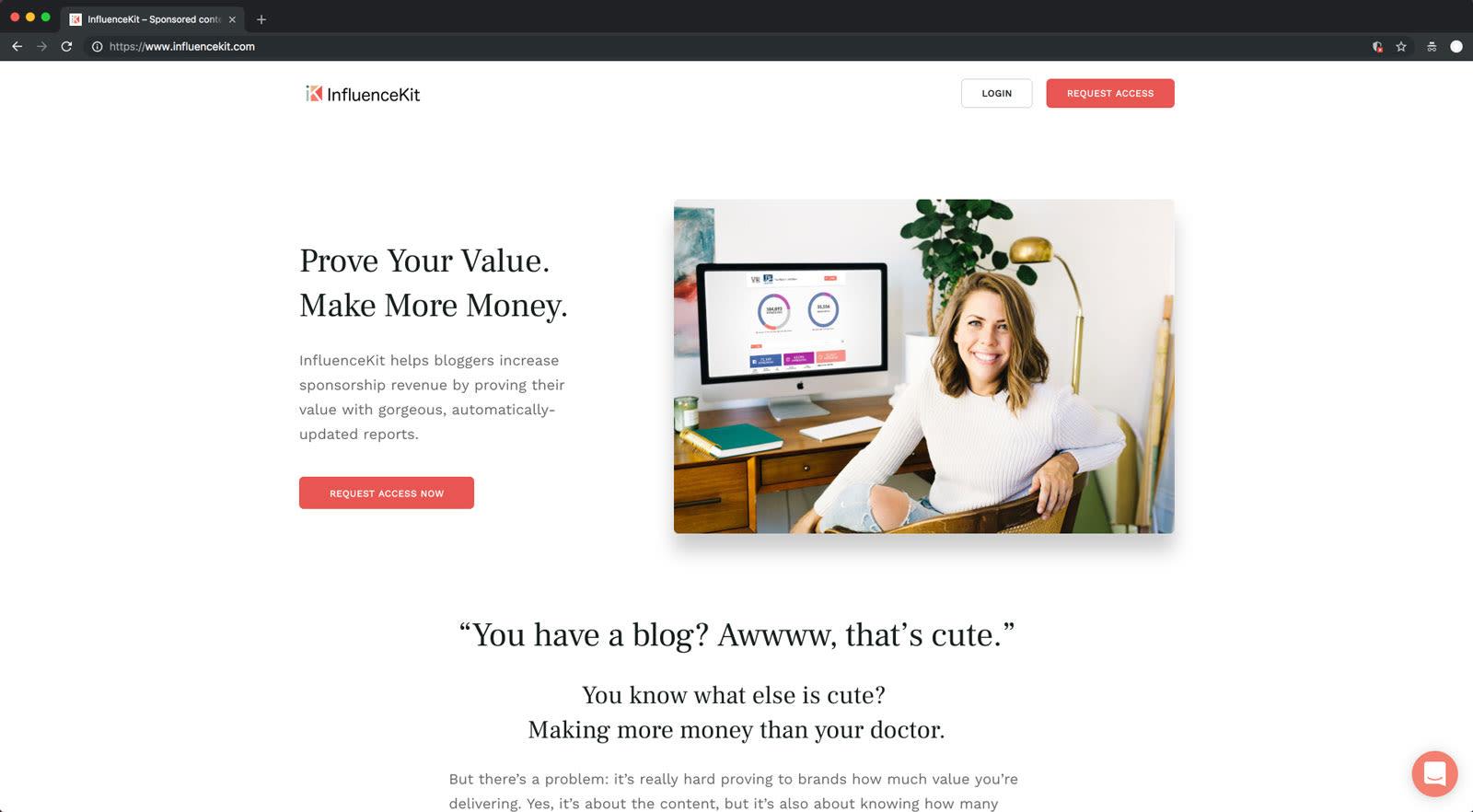
El análisis
Mi primera impresión es cuánto está bien con este ejemplar de página de aterrizaje. Se lee bien y sigue algunas de las prácticas recomendadas de redacción más sólidas, que incluyen:
- Eliminación de llamadas a la acción que distraen la atención (p. ej., ausencia de navegación global)
- Enganchar a los visitantes de inmediato con un beneficio muy deseable (por qué debería importarles)
- Ampliar el beneficio admitiendo productos específicos (cómo lo hace el producto)
- Formato de la copia para la máxima legibilidad. (Los tres párrafos de la copia del cuerpo en «¿Tienes un blog?» es una columna manejable para leer en lugar de abarcar el ancho de la página, lo que es extremadamente fatigante para el ojo lector).
- Usar una voz que esté presente, pero no sea abrumadora. (Con pocas excepciones, han usado su voz solo en crucetas, minimizando las «interrupciones» en la forma en que los lectores procesan información).
- Liderar «contigo» siempre que sea posible
- Hacer que las frases sean cortas y fáciles de consumir
La copia de la página de aterrizaje ha trabajado muy bien: el desafío es que no la ha aprovechado. Después de presentar un argumento convincente a la perspectiva, se olvida de terminar con una llamada a la acción. El marco de AIDA puede ayudar a describir esta progresión y la oportunidad perdida.
AIDA: atención, interés, deseo, acción
Acapara su atención. en este caso, InfluenceKit comienza a generar confianza y empatía al articular claramente el problema al que se enfrentan muchos blogueros: demostrar valor del contenido. El texto dice:
...es muy difícil demostrar a las marcas cuánto valor estás ofreciendo.
Aumentar su interés en el tema. Aquí, la copia profundiza esa comprensión mediante la elaboración del problema, lo que provoca que los lectores asienten con la cabeza y se reconozcan más plenamente en el desafío. Este entendimiento compartido genera más interés. La copia continúa:
Sí, se trata del contenido, pero también de saber cuántas vidas se vieron afectadas por lo que creaste.
A todos nos gusta saber adónde va nuestro dinero (ay ay, Target). Las marcas son como nosotros; quieren saber qué están recibiendo por su inversión. Reportar impresiones es el estándar del sector para el marketing en Internet, y hasta ahora, los blogueros han sido un agujero negro de información.
Tu blog es algo más que fotos bonitas; tienes una influencia real. Tú lo sabes, nosotros lo sabemos y juntos vamos a demostrarlo.
Convierte ese interés casual en un deseo directo para que agreguen la solución a sus vidas. La solución que se ofrece es concisa y clara. El texto dice lo siguiente:
Muestra tu influencia real con informes potentes y dinámicos.
Llámalos a la acción. Hay una llamada a la acción, pero está en el lugar equivocado. Está enterrado debajo de una lista de integraciones, el proceso de cuatro pasos para configurar InfluenceKit, una infografía sobre los dos tipos de blogueros y una sección de conocer al equipo. Por último, hay una llamada a la acción:
¿Todo listo para demostrar tu valor y ganar más dinero? Solicitud de acceso ahora (apretón de manos secreto a seguir).
la copia ha justificado de forma suficiente la adopción de medidas al final de la sección de cuatro partes «¿Cómo funciona InfluenceKit?». Aquí, espero y animo una sección de cierre que incluya lo siguiente:
Una reelaboración de la propuesta de valor
Una lista rápida de los resultados generados por la solución
Una potente captura de pantalla
UNA LLAMADA A LA ACCIÓN
Un testimonio de un bloguero o patrocinador
Un punto de datos sobre los resultados promedio
Tal vez InfluenceKit sea una empresa más nueva, por lo que aún no hay datos sobre cómo está dando sus frutos. Pero hay poder en ser nuevo. Sugiero que los fundadores compartan su propia historia y resultados gracias a InfluenceKit, siendo transparentes todo el tiempo en que son los fundadores, para demostrar que otros también pueden beneficiarse. Parte de causar una primera impresión duradera es crear un espacio para que no solo un potencial se relacione, sino que actúe e interactúe. Eso convierte una impresión en una relación.
Madurez del mercado: refleja el estado de tu mercado en tu copia
Empresa: Nomba
Qué hace: primera marca digital de golosina vegana
Desafío de la página de aterrizaje: el modelo a probar o demostrar
La solución a aplicar: traza un mapa de tu mercado sobre tu primer compromiso con el cliente.
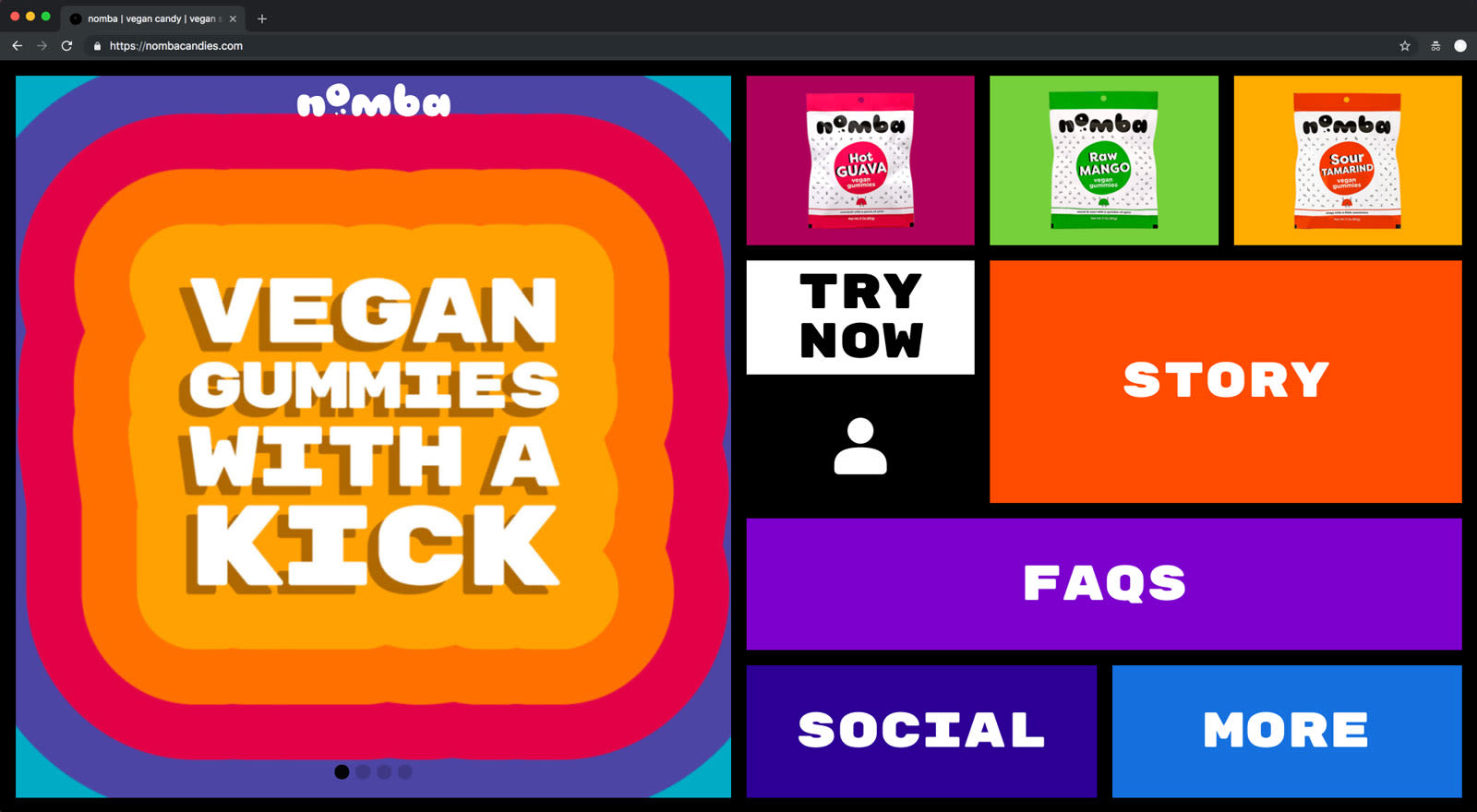
El análisis
El lenguaje «Prueba ahora» en la parte superior de la página de aterrizaje y en todo el sitio es confuso, pero lo que es más desconcertante es la idea de una prueba para este producto.
Para el consumidor general, las pruebas no son típicas en el mundo de la compra de golosinas. Cuando te ofrecen una prueba, has tomado efectivamente un mercado de compradores supersofisticado, personas que han comprado golosinas, entienden la compra de estas y solo quieren obtenerlas veganas y has generado dudas. De repente, los visitantes hacen pequeñas preguntas que se convierten en preocupaciones más grandes:
¿Qué significa una prueba en el mundo de los caramelos?
¿Pruebas los alimentos que me envían? ¿Los envío de vuelta?
¿Obtendré una muestra o un producto de tamaño completo?
Espera. ¿Es una suscripción de la que tendré que trabajar para salir?
¿Quiero golosinas picantes?
Y así como así, se han ido.
Tus visitantes pasan de querer darle una oportunidad a esta golosina vegana picante a rechazarla y sentir alivio de haber salido de allí tan rápido como lo hicieron.
La copia de Nomba tiene un nuevo desafío: necesita lidiar con el «problema» de que los clientes potenciales no entiendan el modelo de prueba para una comida. A continuación, te explicamos cómo puede hacerlo:
Primero, debes saber que tienes que abordar el problema. Pero no tienes que entrar en grandes detalles para abordarlo. Después de todo, se trata de una golosina de $5 o una inversión de $15 en azúcar.
En segundo lugar, pregunta: ¿cuál es la forma más fácil y rápida de abordar el problema? A menudo, está en la denominación. A veces, las funcionalidades del producto se explican mejor renombrándolas y los niveles tarifarios se explican mejor volviendo a etiquetar cada nivel. En este caso, es posible que el ensayo se comprenda mejor renombrándolo a paquete de muestras o muestreador.
Ahora, la llamada a la acción «Prueba ahora» podría convertirse en cualquiera de las siguientes:
Obtén el muestreador
Muestra de Nomba
Pruébalo
Nomba debe mantener ese nuevo lenguaje coherente a lo largo de cada página de producto y proceso de compra para evitar más confusiones. Cualquier Startup que ofrezca demostraciones o pruebas para ganar clientes debe elaborar su copia teniendo en cuenta no solo a su cliente sino a su mercado existente. La parte de mercado de la adecuación producto/mercado también importa.
Empresa: eve
Qué hace: software de gestión de eventos
Desafío de la página de aterrizaje: énfasis excesivo en la solución, no en el problema
La solución a aplicar: marco PAS
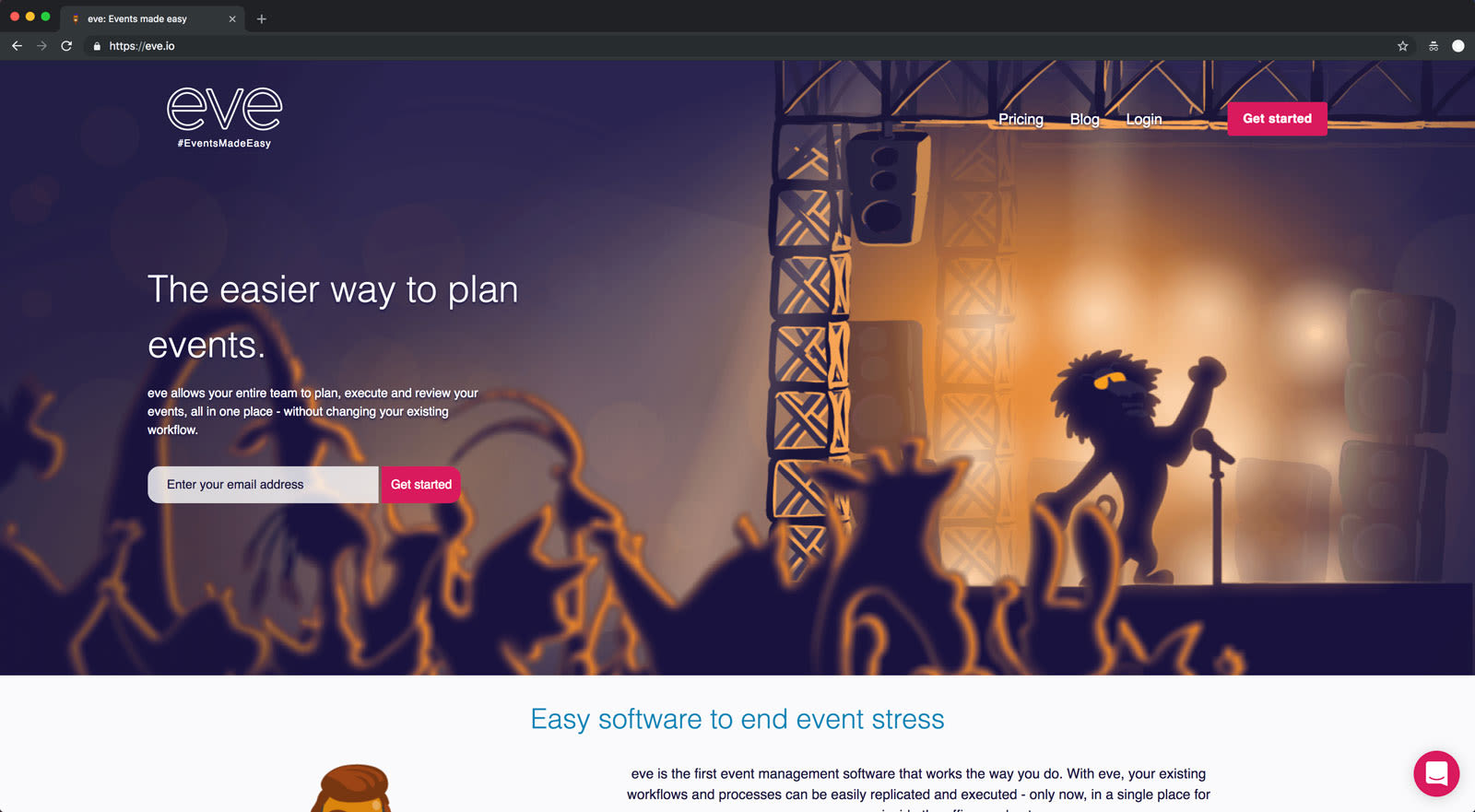
El análisis
Es posible que las perspectivas de un software de gestión de eventos ya reconozcan la necesidad de una solución, pero si no es así, esta página de aterrizaje necesita más información sobre los desafíos de la planificación de eventos. Después de todo, la realización de eventos es muy compleja: múltiples partes interesadas, cambios en los historiales, numerosos proveedores y cambios en las agendas. La lista continúa.
La página de aterrizaje comienza relativamente fuerte con un titular impulsado por los beneficios y una propuesta de valor a nivel de producto:
La forma más fácil de planificar eventos.
eve permite que todo tu equipo planifique, ejecute y revise tus eventos, todo en un solo lugar, sin cambiar tu flujo de trabajo existente.
Liderar con una propuesta de valor es la opción estándar para las empresas de SaaS. Está bien, pero muchos profesionales del marketing luchan con lo que debería ir a continuación en la página. Para un producto como eve, el cual es fácil para el prospecto y el mundo entero minimizar la molestia de la planificación de eventos hasta que estás a dos días del evento y entres en pánico, recomendaría pasar rápidamente de discutir el valor a describir y dar cuerpo al problema que resuelve eve.
Puede parecer que eso se logra con el primer intento del héroe:
Software fácil para poner fin al estrés de los eventos
Pero esa cruceta conduce con la solución («software fácil») cuando debería centrarse completamente en el dolor («estrés por eventos»). El marco del PAS (o Problema, agitación, solución) ayuda a presentar la copia de una manera que se concentre en la fuerza impulsora detrás de la elección de una solución analgésica como eve: el malestar.
Mi mayor consejo es que elijas un texto que no se deslice sobre ese malestar, así que cambia esto:
“¿Qué tan difícil podría ser planificar y coordinar un evento activo?”
con esto:
«¿Qué tan difícil podría ser planificar y coordinar una conferencia de dos días con 20 ponentes de todo el mundo y 500 asistentes?»
La primera opción es segura. La segunda opción es difícil.
Con demasiada frecuencia, intentamos reducir todo a su versión más segura. Y sacrificamos textos específicos y difíciles que podrían enganchar y convertir a los clientes potenciales reales. No es nuestra culpa. Todos los que conocemos están escribiendo textos seguros. Si nos ponemos en negrita, estamos asumiendo un riesgo.
Pruébalo y verás, pero mi aliento es ir a por él. Rara es la empresa que hace olas hoy sin ni 1) un enorme presupuesto de marketing para superar su mensaje seguro ni 2) una forma memorable de conectarse con las personas. Esfuérzate por ser incómodamente específico con tus prospectos. Demuestra que estás en contacto con la molestia precisa que sienten los profesionales de tu mercado.
Empresa: Scribendi
Qué hace: servicios de edición y corrección de documentos en inglés
Desafío de página de aterrizaje: comprende cómo crecer y obtener resultados
La solución a aplicar: visualiza (no solo muestras) los datos.
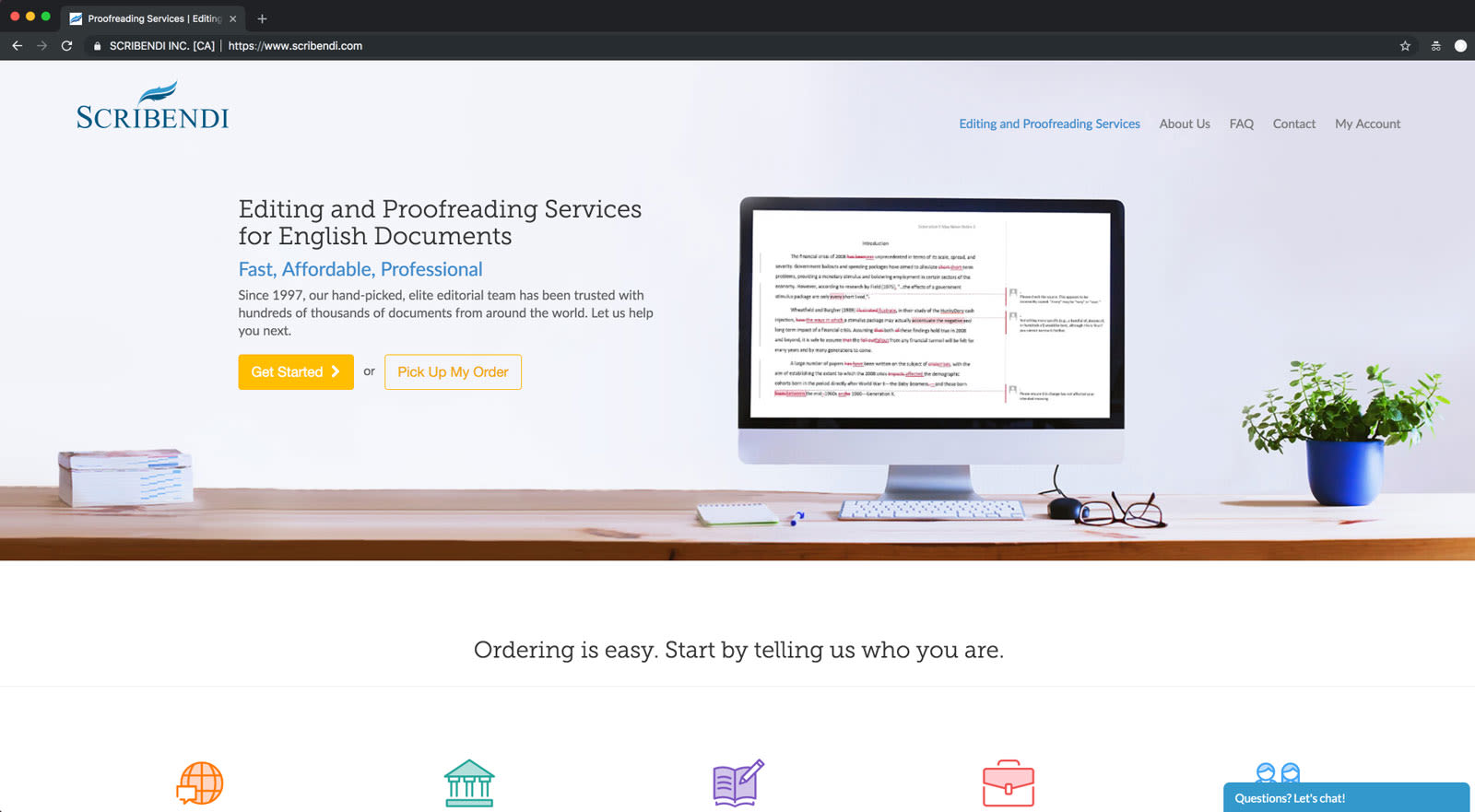
El análisis
En general, la copia de esta página es sólida, pero no siempre son palabras, sino números.
Más abajo, hay una prueba impresionante del impacto en los clientes atendidos, las palabras corregidas y los editores en acción:
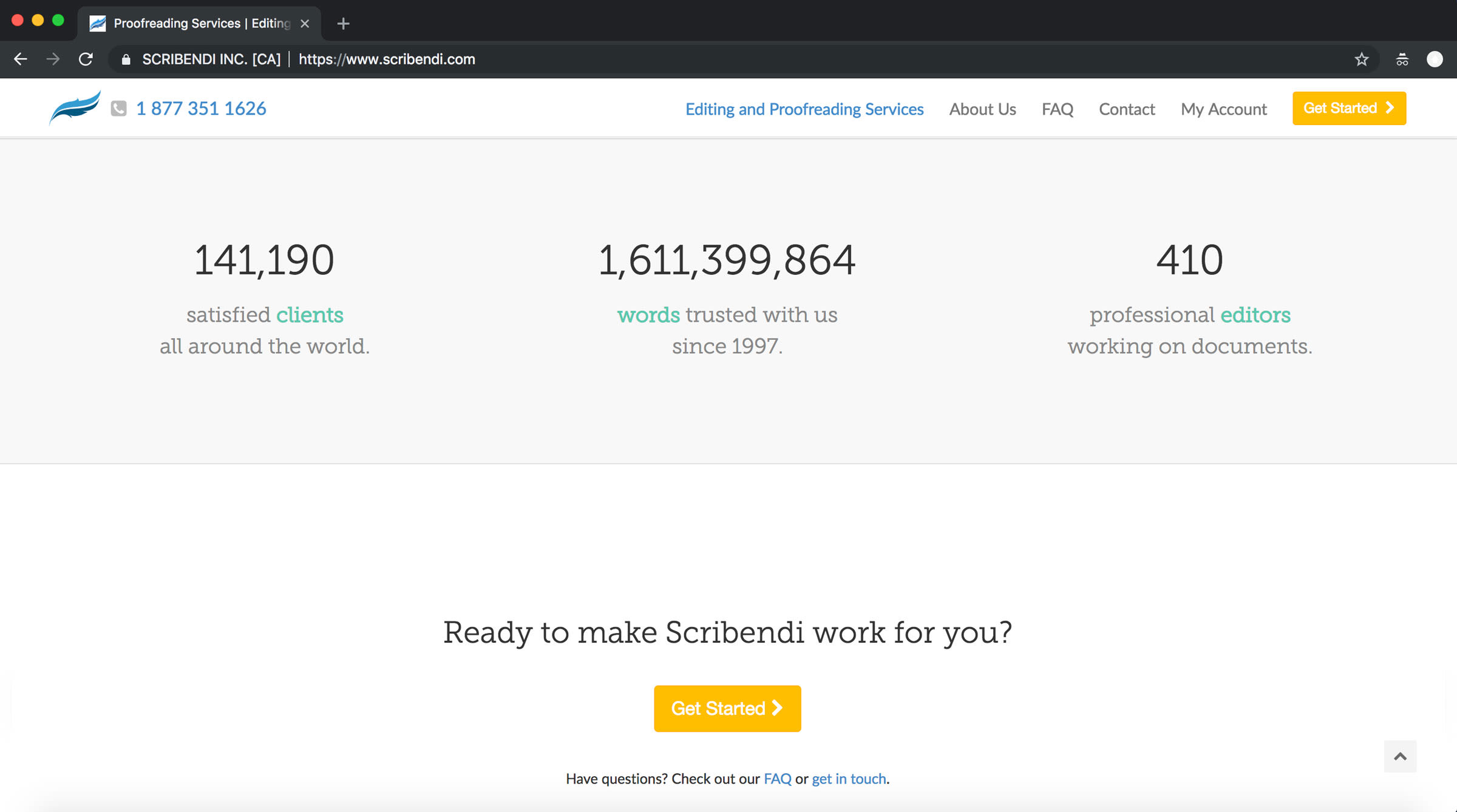
Son cifras sorprendentes, pero también conllevan complicaciones.
Primero, estoy seguro de que no soy la única persona que malinterpretó 1.6B como 1.6M. Eso suena como mucho, pero ¿cuántos documentos significa eso? ¿Son más de 10,000 documentos de ESL para académicos o 100,000 ensayos para estudiantes universitarios?
Sugiero mantener los datos como están, pero agregando una imagen que muestre cómo crece el logro. A continuación, te mostramos una forma de volver a una imagen convincente a través de un cálculo rápido: 1.6B palabras son en realidad 6.4M páginas. Son 318,939 milímetros. Son 1,046 pies. Es increíble. Es más de la mitad del tamaño de la Torre CN en Canadá o inserta tu hito local relevante para tu audiencia.
Ayuda a tus clientes potenciales a visualizar el trabajo que has hecho y no tengas miedo de hacer referencia a algo fuera de tu mercado para defenderlo. Los números son buenos. Pero creo que el dicho dice: quien haga un dibujo gana.
Concienciación del cliente: mapea la conciencia de tus clientes
Empresa: Join it
Qué hace: software de gestión de miembros
Desafío de la página de aterrizaje: asume que el visitante conoce la solución
La solución a aplicar: cambia a la mentalidad de un prospecto consciente de la solución.
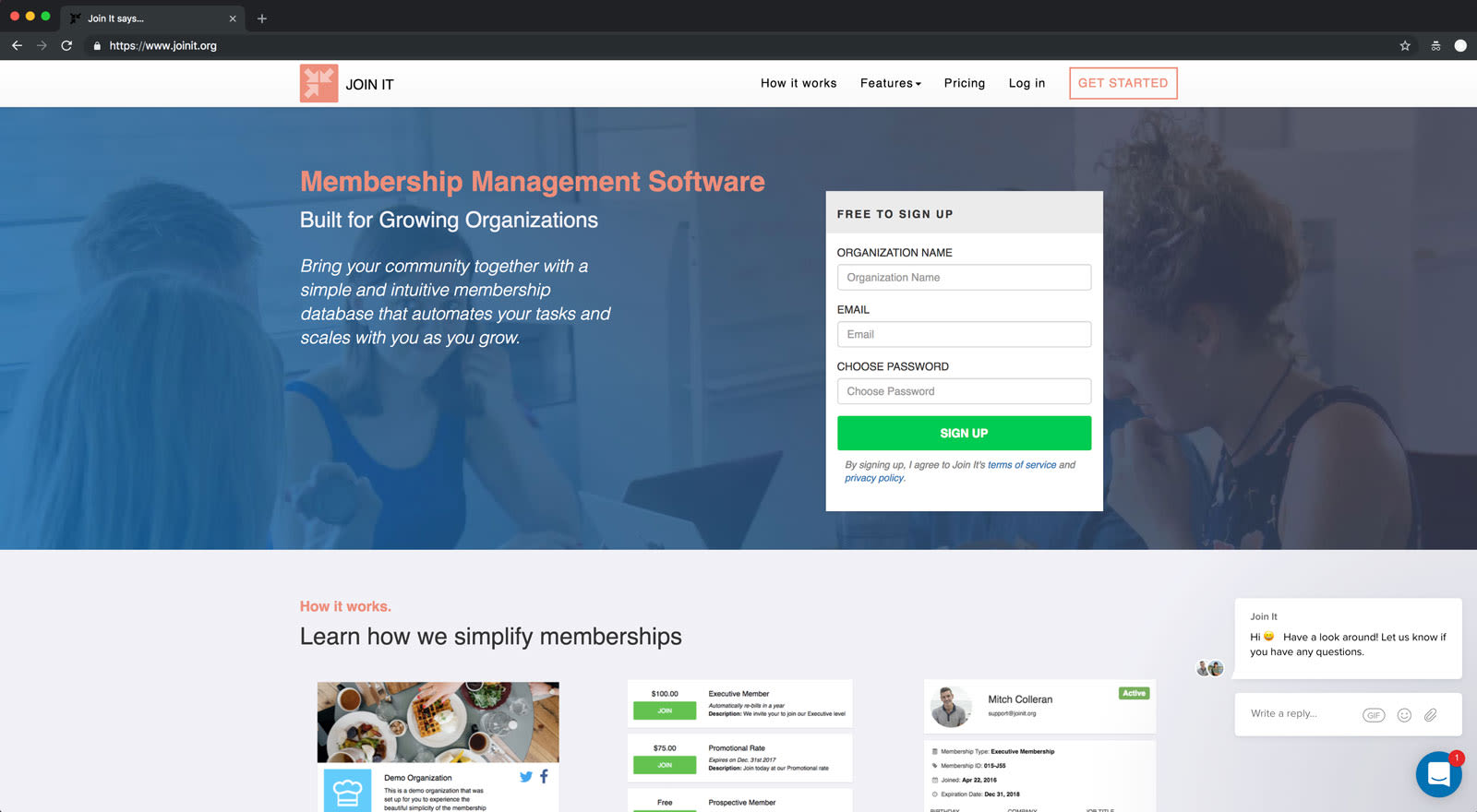
El análisis
Este encabezado, Software de gestión de membresías, es ideal para la optimización de motores de búsqueda (SEO), pero es tan técnico que es irritante, en especial por las primeras tres palabras en negrita de la página.
Para que un titular como «Software de gestión de membresías» funcione, sus perspectivas deben ser sofisticadas y «conscientes de la solución». Aquí es donde se acumulan las cinco etapas de concientización:
Más conscientes. Los visitantes entienden totalmente tu solución y es probable que crean que es un gran competidor para ellos. Solo necesitan impulsos. Las compras se realizan aquí.
Conoce el producto. Los visitantes están aprendiendo sobre tu producto. Aquí se ofrecen pruebas gratuitas, demostraciones y compras.
Solución consciente. Los visitantes están considerando soluciones a su malestar o problema.
Problema consciente. Los visitantes están sintiendo malestar o lidiando con un problema.
Desconocimiento. Los visitantes no han experimentado una necesidad que los lleve a tu solución.
Si los clientes potenciales conocen la solución, buscan activamente un «software de gestión de membresías» y lo llamarían así fácilmente. Sin embargo, Join It está eliminando un segmento de clientes potenciales al dirigirse solo a los visitantes que conocen la solución. Cuando se precisan los titulares y la copia para que coincidan con los problemas o el estado de ánimo de los clientes potenciales, Join It puede abrir su apertura para capturar más clientes potenciales. Así es como podría verse con los ajustes para copiar:
|
Mentalidad inicial del cliente potencial que sabe que necesita una solución
|
Copia de encabezado correspondiente
|
|---|---|
| Me dijeron que el software de gestión de membresías puede ayudarme a automatizar todas las tareas de la comunidad que me plantean dificultades. | Ahora puedes automatizar la participación de la comunidad con un sencillo software de gestión de membresías |
| Necesito un software de gestión de membresías que realice todas estas acciones. |
Las organizaciones de rápido crecimiento necesitan un software de gestión de membresías que:
|
| Estoy pensando en cambiar el software de gestión de membresías X, ya que no me gusta porque Y. | Ponga fin a Y con un software de gestión de membresías que sea sencillo y permita crecer |
| ¿Debería asustarme por todo el trabajo que conlleva implementar una solución de gestión de membresías en mi organización? |
Software de gestión de membresías ¿Cuánto más fácil sería hacer crecer tu negocio si pudieras automatizar tu comunidad? |
Un cambio del lenguaje de conocimiento de la solución al estado mental de un cliente potencial puede parecer que estás cambiando a un visitante consciente del problema. Esta etapa del visitante puede parecer más alejada de un cliente potencial consciente del producto, en la cual puede ocurrir una venta.
Pero dada la madurez del mercado para el software de gestión de membresías, Join It abrirá su parte superior del canal a más clientes potenciales si hace que su encabezado sea más accesible para más visitantes. Y seguirá siendo identificable para los potenciales clientes conscientes de las soluciones y del producto.
Empresa: Parkpnp
Qué hace: Marketplace para plazas de aparcamiento no utilizadas o infrautilizadas
Desafío de la página de aterrizaje: suposiciones incorrectas sobre el visitante
La solución a aplicar: «La regla de uno»
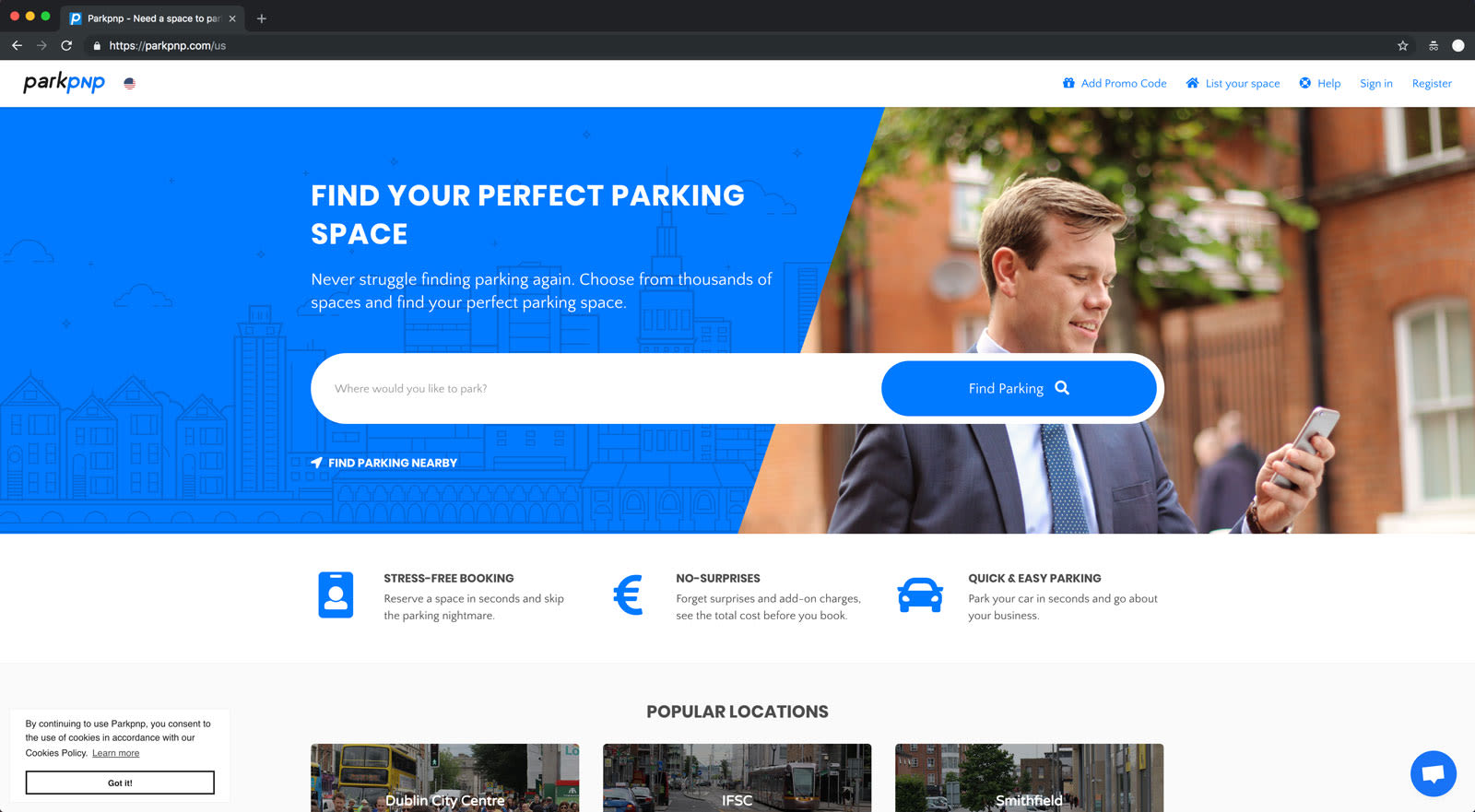
Una parte clave del conocimiento del cliente es comprender el contexto y el impulso de su visita, la cual debe reflejarse en la copia y la experiencia de una página. Ese matiz puede ser la diferencia entre un visitante que te identifica como un héroe en sus vidas o un villano.
En el caso de Parkpnp, el contexto y el impulso son factores fundamentales para su solución. Una aplicación que te permita encontrar un espacio de estacionamiento podría utilizarse por adelantado a una experiencia de estacionamiento molesta anticipada, como los grandes eventos deportivos. Pero es más probable que se utilice en el calor del momento, cuando el dolor para un posible cliente es más visceral y abundan las distracciones.
En resumen, la mayoría de las personas usarán Parkpnp cuando conduzcan sus automóviles buscando un lugar para estacionar en una zona concurrida. Su malestar es alto. Su motivación para resolverlo es alta.
Necesitan un héroe.
¿Tu sitio es un héroe o un villano en ese momento?
La copia y la experiencia actuales de la sección de héroe configuran la solución para ser más el villano que el héroe. En primer lugar, pone trabajo en la bandeja del usuario cuando pide una dirección, lo que se cumple tanto en móviles como escritorio. Pero quizás más flagrantemente, hace suposiciones sobre lo que «perfecto» significa para el usuario. De hecho, aparcamiento perfecto podría significar:
Está cerca de donde estoy ahora.
Está más cerca de mi destino final.
Está disponible ahora.
Está disponible regularmente/siempre.
Permite aparcamiento nocturno.
Es la opción más barata en los alrededores.
Es gratis.
Acepta pagos con tarjeta de crédito.
Está patrullado por seguridad.
Está cubierto.
Cuenta con plazas de aparcamiento muy amplias.
No requiere estacionamiento paralelo.
Tiene acceso para necesidades especiales.
La palabra «perfecto» está tratando de cubrir todo tipo de deseos en el titular de esta página. Pero perfecto para usuario A puede no ser perfecto para usuario B. Aquí es donde la empresa necesita tomar una decisión: ¿cuál es la definición principal del prospecto primario de estacionamiento perfecto en el momento en que utilizan la solución?
Esta pregunta llega al corazón de lo que los redactores llaman la regla de uno, que sostiene que siempre estás escribiendo una página de aterrizaje con los siguientes cuatro puntos identificados primero:
Tu lector único
Tu única gran idea (o idea que cambia la cultura)
Tu promesa única (o resultado medible deseable)
Tu única oferta
De todas las partes de la regla de uno, tu lector único es la más importante. No puedes escribir una página eficaz sin identificar primero tu lector único. Una vez que conozcas bien tu lector único, sabrás qué dolores los impulsan, qué beneficios buscan, a qué oferta es más probable que respondan mejor, qué tipos de pruebas sociales los moverán, la lista continúa. No tienes que ser demasiado detallado en tu lector único, pero tienes que conocerlos lo suficientemente bien como para mirar la lista anterior de definiciones de estacionamiento perfecto y saber cuál elegirían si solo pudieran elegir uno.
El que usarían es el que usas tú.
En el caso de Parkpnp, si el lector único define estacionamiento perfecto como estacionamiento que está cerca de donde estoy ahora, el titular cambiaría y también cambiaría la llamada a la acción. A continuación, te explicamos cómo:
|
De…
|
Para…
|
|
|---|---|---|
|
Encabezado
|
Encuentra el estacionamiento perfecto | Encuentra ahora un lugar cercano para poder estacionar |
|
Llamado a la acción principal
|
Campo: ¿Dónde te gustaría estacionar? Botón: Busca estacionamiento |
Botón: Busca estacionamiento cerca de mí ahora |
|
Llamado a la acción secundario
|
Botón: Busca estacionamiento cerca | Enlace: Busca estacionamiento para una fecha futura, un evento o una necesidad a largo plazo |
Así es como tu sitio pasa de ser un villano a un héroe.
Ahora, si tu lector único define estacionamiento perfecto como estacionamiento cerca de mi trabajo que no cuesta la mitad de mi sueldo o estacionamiento seguro para mi hija que está fuera en la universidad, es decir, si está planeando necesidades de estacionamiento futuras, el titular y la experiencia cambiarían en consecuencia, por supuesto. No tienes que ser específico. Pero si puedes obtener ese detalle en tu titular, es más probable que conviertas a tu visitante. La alternativa es escribir un titular que sirva a una gran variedad de audiencias. Pero, ten en cuenta: un héroe para todos es un personaje aburrido y más probable que sea ineficaz para la empresa.
Empresa: eCourtDate
Qué hace: recordatorios digitales oportunos de la fecha del tribunal
Desafío de la página de aterrizaje: no está claro quién es el usuario
La corrección a aplicar: declaración «ideal para»
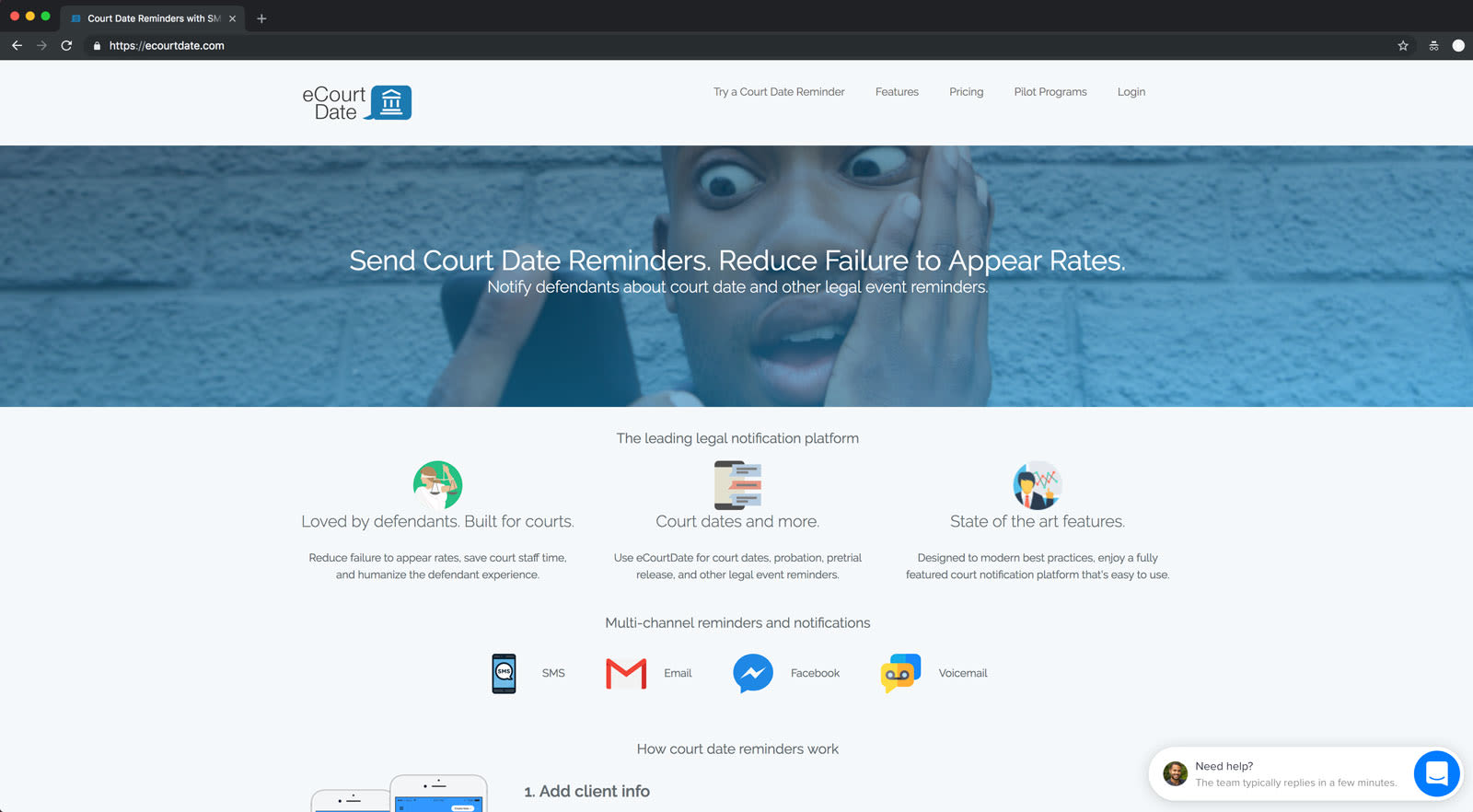
Esta es la primera pregunta, y la más importante, sobre la página de aterrizaje de eCourtDate: ¿la gente llega a esta página y sabe si el servicio está destinado a ellos?
Una de las formas más limpias y sencillas de optimizar tu copia es usar una declaración de «ideal para». Esa declaración puede aparecer en cualquier lugar de tu sitio, pero lo mejor es que aparezca más cerca de la parte superior de tu página de aterrizaje. Eso es especialmente cierto para un servicio como eCourtDate, en el que el usuario no es claro. Puede ser para abogados, agentes de policía, el tribunal, acusados y demandantes, incluso para aquellos que cumplen funciones de jurado.
Cualquiera que sea, pon eso en la página en una declaración «ideal para» como la siguiente:
Ideal para abogados con casos penales y de DUI
Si es para más de un usuario, está bien. Pon esos nombres en la página:
Ideal para abogados criminalistas, policías de tránsito y administradores de juzgados
A partir de ahí, el titular y el subtítulo del héroe tienen contexto y comunican el servicio con mayor claridad. Toma algunas medidas adicionales para mejorar la copia. Responde por qué es importante y agrega una prueba de que lo has hecho. Esta regla se conoce como «Y qué»/«Pruébalo».
Así es como podría verse la copia con esos dos elementos abordados:
Ideal para administradores de juzgados ocupados
Envía recordatorios de la fecha de la corte.
Reduce las tasas de incomparecencia.
Notifica a los acusados sobre las fechas de la corte y otros eventos legales. Ahorra hasta 20 horas por mes de tiempo del personal de la corte. Reduce las no presentaciones en la corte en un 33 %. Y humaniza la experiencia del acusado.
Refuerza esta copia con testimonios de personal judicial o jueces que antes estaban frustrados y ahora contentos. Todas estas mejoras se derivan de articular el usuario ideal para el servicio al principio.
Da el primer paso con la copia de tu página de aterrizaje
La copia de la página de aterrizaje es una herramienta poderosa y sin apalancamiento. Hecha bien, genera marca y confianza, además vende productos a cualquier persona con conexión a Internet, según su horario. Pero no es automática. La copia de la página de aterrizaje debe dar una primera impresión convincente, considerar la madurez del mercado y reflejar la etapa de concientización del cliente. Debe satisfacer a los posibles clientes donde están y llevarlos a donde ellos y la empresa quieren que estén. Una vez que lo hace, mover las manos se convierte en chocar los cinco y chocar los cinco en apretones de manos, las conversiones pueden ocurrir sin mucha intervención humana.
No pienses demasiado por dónde debes empezar. Solo Empieza. Una página de aterrizaje siempre puede y debe mejorar. Si tienes tiempo y recursos limitados, revisa las victorias rápidas para hacer ajustes que generen ganancias enormes. Si tienes más tiempo, renueva tu copia para orientarte y causar una impresión duradera, la madurez del mercado y la conciencia del cliente.
La copia de la página de aterrizaje es solo un canal para el cliente. Obtén consejos sobre marketing de correo electrónico o perfecciona tus correos electrónicos fríos y llamadas con esta guía para encontrar a tus primeros clientes. Si hay un tema relacionado que desearías que cubriéramos, escríbenos a: Atlas@stripe.com
